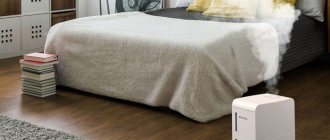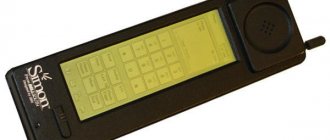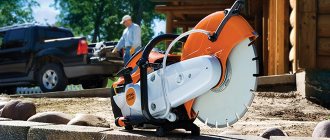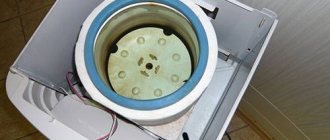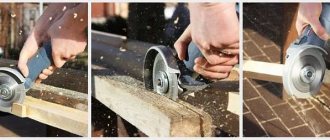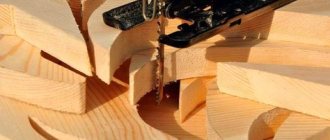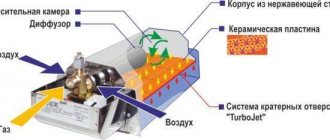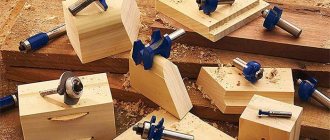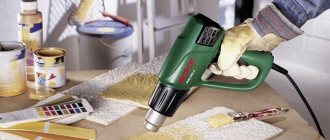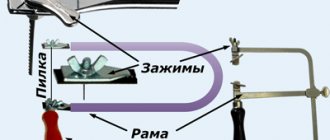How does a grinder work?
The operation of the grinder is based on the effect of friction of the abrasive surface of the tool on the base being processed.
There are several principles of operation of a power tool:
- Vibration. Characterized by forward-return movement.
- Circular. Movement occurs around an axis.
- Combined (eccentric). Combines two operating principles - axial rotation and vibration.
- Linear continuous. Typical for a belt type tool.
Work must be carried out in the following sequence:
- connect the equipment to the outlet;
- provide a comfortable hand grip;
- turn on;
- wait until the unit picks up speed;
- bring it to the surface to be treated and start sanding.
By following the steps, you can avoid injury and damage to the device.
Any sander has the following elements in its design:
- Engine . The most common type is collector; in the most modern models it can be collectorless. But the cost of the second option is quite high. But periodic replacement of brushes is not required.
- Power : mains, battery, pneumatic.
- Working platform on which abrasive replaceable sheets, tapes, discs are fixed.
- Handle . Depending on the model, there may be 1-2 handles.
- Control system .
On/off, speed control. Well-known brands have additional auto-adjustment. The moment grinding begins, the machine's performance drops due to friction. Professional equipment contains a sensor that controls the speed, which allows you to maintain the required intensity of torque. - Disk . The diameter of the disk directly depends on the engine power. The higher the capabilities of the unit, the larger the disk can be used.
Depending on the type of grinder, there may be differences in design.
What to look for when choosing
There are a few things to consider before purchasing:
- Dimensions, sole material depending on the selected type of sander.
- Smooth start, several speed modes, fixed power button.
- Possibility of connecting a vacuum cleaner to collect dust and fine sanded material. Selected depending on the intensity of “dirty” work.
- Availability of automatic speed control to maintain torque speed.
- Regulator of belt position and tension (for draw machines).
- Weight and dimensions of the machine. It is better to choose a device that is less powerful, but faster. This option will weigh less and cost less.
- Ease of use. You need to decide on the type of handle. The most convenient are considered to be a mushroom and a bracket. It is worth considering the location of the switches and the ease of changing equipment.
- Brand. For home use, you can purchase reliable and trusted manufacturers Makita, Black&Decker, Skil, Sparky, Bosch. Hammer, Metabo. Good devices are offered by domestic brands Fiolent and ZUBR.
Types and functions of grinding machines
There is no strict classification for power grinding tools. Some of them are named according to the operating principle, others - according to the features of the device, and others - according to the specific application.
Grinding Polishing Machine
The name speaks for itself; this technique is used for final surface polishing and restoration work. This equipment is used in the automotive industry and the finishing cleaning of varnished wooden products, including parquet. Based on the principle of operation, orbital and eccentric models are produced.
Polishing machines have the following technical characteristics:
- Power consumption 901 – 1200 W. In this case, there must be a high-quality gearbox. Compared to an angle grinder (angle grinder), it has a higher transmission torque.
- The maximum disk diameter is 181 - 230 mm; for floor-standing machines it can be 800 mm.
- Weight . The greater the engine power, the heavier and larger the equipment itself will be. For polishing work that is considered delicate, it is better to take a small unit up to 2 kg.
- Number of revolutions from 600 to 3000 rpm. Do not forget that this indicator is set in the idle position; with the action and increase of the friction force, this indicator will fall.
Additional functions:
- Automatic speed adjustment . This function will produce a specified parameter at the output and during operation, which will significantly improve the quality of the polished surface.
- Smooth start is an important function that will prevent the equipment from jumping out of your hand when starting up, and when using polishing liquids it will not splash in all directions.
- Protection against accidental activation. How relevant this function is for polishing machines is to be decided individually.
- Overload protection . This equipment is not designed for high speeds, and the design involves a special gearbox structure that can withstand increased load.
- Connecting the dust collector . Polishing machines are used more for final polishing, which does not produce significant dust. Therefore this function is not so important. But if you plan to use it frequently and for cleaning, then it is better to provide a model with this capability.
Accessories and equipment for polishing machines depend on the application:
- Disks . These can be soft polishing materials or abrasive ones. Fastening occurs to the platform using clips or Velcro. The second option is more popular.
- The additional handle provides a comfortable grip. Relevant for larger models.
- The bar is needed when working in hard-to-reach places.
- Case . By default, a branded tool has a “packaging” that ensures safe storage and movement of the equipment.
- Dust collector . Depending on the intensity of “dirty” work. At high rates, it is better to use a construction manual vacuum cleaner.
There are models that operate from the mains, battery, or compressor. The first two are used for domestic needs and in the semi-professional field.
Compressor connection is typical for professional industries and high intensity of operation.
angle grinder
The universal angle grinder (angle grinder) is designed for cutting and processing various materials: metal, ceramics, tiles, concrete, plastic, laminated veneer lumber, wood. This tool in its design has an important difference from the previous one - high speed. Associated with versatility of use.
The devices should not be used intensively as polishing tools.
Used for short-term work without overload. The grinding produced by an angle grinder is coarser and is suitable for stripping than for finishing polishing.
By design, angle grinders can be one-handed or two-handed. The second type is classified as a professional line.
Specifications:
- Power consumption . One-handed (household use) - 600-900 W, 1200-1500 W, two-handed - 1800 - 2100 W.
- Maximum disc diameter > 230 mm. For such consumable circles, the recommended speed is 8000 - 10000 rpm, for small ones - 10001 - 12000 rpm. For domestic needs, discs of 116 – 125 mm are used. They can be used for both cleaning the base and rough grinding.
- The number of revolutions directly depends on the power consumption, so the range of values is very large from 1000 to 12000 rpm. The optimal operating range is 4000 – 6000 rpm.
- Weight and dimensions. These parameters also depend on the power of the equipment and reach up to 4.5 kg.
Additional functions can make work more comfortable:
- Automatic speed control. This option is in demand when the equipment is intensively used as a grinding unit. This will avoid rapid wear of the angle grinder.
- Smooth start, protection against accidental switching on. Helps avoid jerking when starting. Ensures safe use.
- Overload protection. An important function, especially if the tool does not provide automatic speed control.
Accessories: cutting and polishing wheels of various types.
Power: mains, battery, pneumatic.
Straight grinder
The device is used for cleaning and finishing grinding of hard-to-reach areas. For this purpose, conical, cylindrical abrasive nozzles, soft and small in diameter, are used. The peculiarity of this tool is its compactness.
The equipment itself is presented in the form of a small handle.
Often the kit is supplemented with an extension trunk, which allows you to work in hard-to-reach, remote places.
Specifications:
- The average power consumption of a straight grinder is in the range of 600-900 W. This is due to the miniature size of the device.
- Maximum disc diameter ≤ 115 mm. There are also more powerful units with the ability to install consumables with a diameter of 126 – 150 mm.
- The speed of such equipment reaches > 12000 rpm. You should know that the lower this indicator, the greater the torque, i.e. the device will not overheat under load.
- Weight. The optimal weight is considered to be from 1.3 to 1.7 kg.
Additional functions.
- Speed regulator. The equipment is used for various types of surfaces, so the function must be present.
- Automatic speed regulator. The specificity of the straight grinder is “jewelry work”. Therefore, this option will not be superfluous.
- It is desirable that the engine be protected from dust.
- Another interesting option is a flexible “trunk” for working in remote, hard-to-reach places.
- Stand, clamp.
Accessories for straight machines:
- conical, spherical, cylindrical abrasive stones;
- abrasive, soft wheels;
- drill;
- cue balls.
The disks are fastened using a scurvy, the optimal size of which is 6 mm.
Power supply: mains, battery; pneumatics. The latter type of connection is used in the production of professional equipment with increased power.
Belt sander
The belt sander (LSM) is the most famous and popular type. At the base of the device there are two rollers on which a closed abrasive belt is pulled. This machine is used for the primary processing of wood surfaces.
When scrolling the tape and moving the equipment along the base, a layer of up to 1 mm is removed. The work is carried out along the grain, this gives a smooth, high-quality base. Processing across the grain will add roughness. Can be used to remove old paintwork.
Considering the design features, the tape machine will not cope well with working with metal and plastic. Associated with high equipment performance, which can lead to heating of the base due to friction and deformation.
It is not recommended to treat surfaces with significant unevenness.
It will not be possible to perform the processing efficiently, and it threatens to wear out the consumables.
There are models for processing convex and concave surfaces.
Belt sanders have the following technical characteristics:
- Power consumption. The model range is quite large, there are low-power equipment with narrow tapes (601 - 900 W) and powerful units (1501 - 1800 W).
- The length and width of the tape depends on the engine power. The first dimension is in the range from 400 – 600 mm. Second, from 65 to 110 mm.
- The rotation speed of such devices ranges from 200 to 700 m/min. For domestic purposes, machines with speeds of 200 - 300 m/min are suitable.
- Weight. The average parameter is up to 4 kg. For high power units it can reach up to 6 kg.
Additional functions:
- Speed regulator. Allows you to work not only with wood substrates, but also with plastic.
- Protection against accidental activation. The need for this function is decided individually.
- Overload protection. As a rule, LBMs are rarely equipped with a speed controller and auto-regulator, so it is advisable to provide this option.
- Connecting the dust collector. Such machines need this option. Processing wood surfaces, especially at high speeds, generates a lot of dust.
- Regulator of tape position and tension.
- A bounding box allows you to remove the same layer in different areas.
Accessories – sanding belts with different abrasive sizes.
Equipment: case (usually in more expensive models), dust collector (if there is a function in the equipment itself), clamps, clips, bounding frame. Clamps help to secure the blade permanently. Power: mains, battery, pneumatic.
Random orbital sander
The equipment is used for fine finishing grinding and polishing. The operating principle is circular and reciprocating motion, which resembles the movement of planets in orbit. Therefore, the device received another name - orbital. It is this distinctive feature that produces a high-quality surface.
Such devices are not recommended for polishing cars and surfaces with significant irregularities.
They cannot be permanently installed for processing small parts due to increased vibration.
The ESH (eccentric sander) has a flat plate-shaped sole onto which the working discs are attached using Velcro or fastening. To remove dust, perforations are provided on the working base of the tool. For fine and polishing work, high speeds are not required.
Basic technical data:
- Power consumption can be ≤ 300 W or in the range of 300 – 600 W. It is typical for ESM that at high power consumption the speed is low, and at low power it is high.
- Maximum disc diameter 215 mm. The range of 126 – 150 mm is considered optimal.
- Number of revolutions and number of oscillations. Unlike other types of grinding machines, EShM has exactly two characteristics. The first can be from ≤ 4000 rpm and go up to 12000 rpm. The number of oscillations will be 2 times greater than the revolutions.
- Weight. Such machines have a small weight in the range of 1.2 -3 kg. Doesn't require much pressure to operate. Quality is achieved through the low speed operating principle.
- An important characteristic is the amplitude of movement. The average is 3-5 mm.
Additional functions:
- Speed regulator. For fine work, the option is needed to expand the range of surfaces to be processed.
- Automatic speed regulator. Its presence is required during intensive operation of the equipment.
- Connection to the dust collector. For ESM, this function is relevant, since work occurs with the appearance of a large amount of fine dust.
- Pressure control. This system helps to apply even pressure to remove an equal layer.
Maximum equipment: additional handle, rod (for working in hard-to-reach places), removable power cable, case, dust collector. Power: mains, battery. Accessories for such equipment are wheels with abrasives of various grain sizes.
Vibro sander
Another name is surface grinding. Used for fine polishing and grinding work. This can be wooden surfaces, or sanding after puttying. The operating principle is based on reciprocating motion. The amplitude of movement is insignificant, at high speed.
The base of the equipment is represented by a flat sole, usually rectangular in shape.
The speed of work depends on its area. Sanding sheets can be attached using Velcro, clips or a combination of fastenings.
There is a dust removal system. For this purpose, special perforations are provided on the sole and sheets. The quality of processing depends on the abrasive of the sanding sheets and the speed.
Specifications:
- Power consumption in the range ≤ 300 W.
- The platform has a rectangular shape, width from 75 to 115 mm, length from 104 to 330 mm.
- The number of revolutions is high in the ranges 8000 – 10000 rpm, 10000 – 12000 rpm, > 12000 rpm, depending on the model.
- The amplitude of movement ranges from 1.5 to 4.5 mm.
- Weight from 1.2 to 2 kg.
Important additional features:
- Speed regulator. This will expand the application possibilities.
- Automatic speed regulator. It will help to perform high-quality fine finishing polishing.
- Soft start, protection against accidental start-up, overload protection are decided individually depending on the intensity of work.
- Connection to the dust collector. A current option that will help reduce room pollution.
- Pressure control.
Accessories: fabric and abrasive sheets, coated mesh. Maximum equipment: case, rod, additional handle, dust collector. Power: mains, battery.
Delta grinder
This equipment option is a type of surface grinder. It has the same purpose and similar characteristics. The only difference is the shape of the platform, which resembles an iron. This allows you to work with complex parts and grind in hard-to-reach places (corners, joints).
Wall grinder
The device is intended for grinding walls, ceilings, floors, and is produced on the basis of eccentric and vibration machines.
A distinctive feature is the presence of a rod into which a dust removal system is mounted.
The weight with the barbell reaches 6-8 kg.
The technical characteristics are the same as those of vibrating or eccentric machines.
Additional functions
- Speed/oscillation regulator. This option will allow you to increase the types of surfaces processed.
- Autoregulator. Allows for uniform removal of the sanding layer.
- Overload protection. Despite the insignificant power, remote control of the equipment does not allow you to control the level of pressure, so it is better to provide this function.
- Pressure control. This is a relevant feature for this device.
- Connection to a vacuum cleaner. For use in construction and finishing works, it is better to provide. This will reduce the emission of harmful dust into the indoor atmosphere.
Accessories: meshes with various coatings, abrasive and fabric attachments. Maximum equipment: case, rod, additional handle.
Grinding machine for stone and concrete
There are two types of devices: for dry stripping and wet. This equipment is widely used in construction and finishing. With its help, you can level concrete and monolithic floors, clean surfaces from old coating and seams, and remove scratches.
The support sole is made in the form of a circle. Grinding discs and cutting heads are attached to it.
Tools for processing stone/concrete can be either hand-held or floor-mounted.
According to the operating principle, these can be eccentric or vibration machines.
Technical characteristics for manual type equipment:
- Power consumption ranges from 900 – 1500 W. More powerful cars may be available.
- Maximum disc size up to 800 mm. For manual units, 125 mm is optimal.
- Number of revolutions depending on model average value ≤ 4000 rpm.
- The weight of hand-held devices is on average 2-3 kg. Floor-standing options can reach up to 124 kg.
Additional functions
- Speed regulator. Expands the scope of application.
- Automatic speed control for manual models allows you to perform work with a uniform load.
- For such equipment, soft start-up, protection against accidental start-up, and overload protection are relevant.
- Connection to the dust collector. Required feature. Grinding concrete and stone surfaces is accompanied by a lot of dust.
Accessories are presented in the form of cutters and grinding wheels. Maximum equipment for manual models: case, additional handle (provides a comfortable grip), dust collector. Power: mains, battery, pneumatic.
Brush grinder
The brush grinder is widely used for cleaning surfaces from paint and varnish coatings, rye. Its use in carpentry is interesting for highlighting the texture of wooden surfaces and aging. Fine polishing and grinding can be done.
The operating principle is similar to that of a tape machine.
Average specifications:
- Power consumption in the ranges 901 – 1200 W, 1201 – 1500 W.
- Roller diameter 120 mm.
- Number of revolutions 1000 – 3000 rpm.
- The weight of the devices is 4-5 kg.
Additional functions:
- Speed regulator. Required because grinding and cleaning of surfaces occurs at different speeds.
- Automatic speed regulator. Useful function for uniform surface treatment.
- Mechanical adjustment of grinding depth.
Accessories: rollers in the form of metal brushes, abrasive-polymer, nylon. Maximum equipment: case. Power: mains, battery.
Basic operational capabilities of polishing machines
There are not too many criteria for choosing such devices, but they are all important - the class of equipment, its power, the weight of the tool, the maximum diameter of the disk, the presence of a speed control system. All polishing machines are divided into two large groups by class - professional and household. If you are going to use this unit from time to time, then you do not need a professional tool, since it will cost much more than a household one.
Power affects the maximum load applied to the machine. Accordingly, a more powerful device can finish the job in less time. This figure usually varies from 400 to 1500 W. The higher the power, the greater the mass of the tool. It is advisable to purchase a design that weighs less - your hands will get less tired when working, and you will not need to take breaks to rest.
The diameter of the polishing disc also affects the overall performance - this parameter ranges from 120 to 240 mm, the most popular models today are those with diameters of 125, 150 and 180 mm. This factor directly affects the power - the higher it is, the greater the power. It is desirable that the machine has an electronic system for adjusting and maintaining speed. This feature will allow the device to maintain a certain number of rotations per minute, regardless of the load on it; accordingly, the work takes less time and is of better quality.
When choosing models for inclusion in our review, we, first of all, paid attention to all the factors discussed above, and also took into account the price-quality ratio of products, and largely relied on user reviews. For each product, we tried to collect the maximum amount of information so that you can choose the optimal tool for yourself.
Advantages
Sanders have undeniable advantages:
- The speed of grinding work is many times higher than during mechanical processing.
- Physical costs are significantly lower than with manual grinding.
- The quality of the resulting surface. The presence of additional functions in the devices allows you to remove a uniform layer from the entire plane.
- When mechanical grinding, dust must be constantly removed. Modern power tools are equipped with a dust collector, or have the ability to connect to a vacuum cleaner, which makes “dirty work” clean.
- A wide range of models allows you to choose the right model for specific materials.
- Various areas of application from “jewelry work” to building a house from timber.
- The main advantage of grinders is to make tedious and heavy mechanical work quickly and efficiently without much effort.
Design and principle of operation
Orbital sanders consist of 3 main elements:
- motor: converts energy into mechanical work, activating the main grinding elements of the eccentric sander;
- working sole: grinds and polishes the surface of the workpiece using a grinding wheel;
- dust collector: collects dirt and waste generated during the part processing procedure;
- handle: designed to fix the tool and hold it in the hands of a person while grinding the product.
Some models of orbital sanders as standard have a regulator - a device for adjusting the stroke of the eccentric, located next to the dust collector.
When processing the surface of a product, a circle is connected to the working sole of the eccentric sander. The motor, using mains power or battery power, supplies energy to the working platform, driving the slightly offset footplate and the working circle. Most devices use electric motors with a brush-commutator unit. The circle begins to rotate, making forward and reciprocating circular movements. By means of an eccentric, it makes additional vibrations during rotation, polishing the product. The speed of the circle is 20,000 revolutions per minute, which allows you to grind parts made of plastic, wood, metals, natural stones and glass.
The effectiveness of grinding and polishing is influenced by the number of handles on the tool. To perform small-volume work, you will need an eccentric sander with 1 handle that fits comfortably in the palm of a person. It is used when processing workpieces whose design contains hard-to-reach elements. To increase comfort during grinding, a stopper is used - a device that locks the orbital sander in automatic mode.
There are the following classifications of eccentric sanders:
- by material: grinding machines for wood, metal, glass, plastic or stone surfaces;
- type of power supply: grinders powered by an outlet (electrical network) or battery;
- scope of application: professional and household grinders;
- size and method of operation: small grinders with the ability to regulate the number of revolutions and large pneumatic devices operating on the power of compressed air.
Thanks to a special design, eccentric sanders quickly and effectively smooth the surface of workpieces and eliminate defects made during the design of products.
Flaws
There are several disadvantages when using grinders:
- The work is carried out in several stages, with changing grinding discs/sheets or different tools.
- Dead zones. Every device has them. You will have to refine it mechanically, or purchase a highly targeted tool (straight sander, delta sander).
- Price - options. Additional features are deferred to the cost of the equipment. By saving on purchase, repair costs are acquired.
- Presence of counterfeits of famous brands.
How to choose a grinder
To select any power tool, you should determine for yourself:
- Scope and area of application. This parameter allows you to focus on a specific type of equipment and decide on accessories and equipment.
- Intensity of use. It will help you choose the right power and number of revolutions.
- Possibility of connecting to the network. In this case, it will be easier to decide what type of power supply the grinder should have - mains, battery, pneumatic.
- Budget. It is decided individually, it helps to indicate to the seller the price segment in which to look for a suitable model.
- Manufacturer. It is better to give preference to well-known brands.
- Guarantee. Warranty conditions and availability of a service center.
- Ergonomics. Before purchasing, you should hold the instrument in your hands. Feel how easy it will be to use.
These are the points that will make choosing a tool easier. It should be remembered that savings on purchase may lead to additional repair costs in the future.
Sanding before painting a car
- It is best to sand the primer dry, as it is porous and absorbs water, which can remain under the paint and cause rust. In hard-to-reach places, the paint can be sanded with water, but then you need to dry the surface well (preferably with infrared drying). In any case, if you sand the soil with water, then drying is mandatory.
- When sanding paintwork for repainting with a machine, you need to use medium speed. It is better to use a soft backing (for more uniform sanding) and apply gentle pressure. A soft backing helps the sanding wheel follow the contours of the panels and reduces the risk of rubbing the surface, but reduces cutting ability.
- The abrasive fibrous material Scotch-Brite should be used in hard-to-reach places and on the edges of panels. It can be used with matting paste. It only makes the surface matte without removing defects.
- The surface must be completely clean before sanding. The panel needs to be processed by dividing it into segments of 50 cm by 50 cm. This way, you will be able to reach all places in the segment you are currently working on and will be able to ensure uniform pressure on the sanding block, since your hand will normally reach the desired place. In addition, it will be clear which area has been processed and which still needs to be sanded. Specialists from the American company Meguiar's teach you to grind with straight movements, not circular ones. If the surface is sanded in a circular motion, the scratches will be more noticeable. Even better, use Abralon at the final stage (see article on preparing for painting).
- When sanding primer or paint before painting, you should also use a sanding block. This could be a rubber block or a foam squeegee. If you sand with paper held in your hand, the sanding marks will be uneven. Your fingers will create more pressure.
- Do not use soapy water to soften the abrasive when working with primer (as you can do when sanding after painting, before polishing). Its components can be absorbed into the soil and will be difficult to remove. They can subsequently affect the paint layer.
Which is better
When choosing a grinder, it is impossible to say unequivocally which tool is best to purchase. We can only outline some distinctive characteristics that you should pay attention to.
- For polishing cars and paint surfaces, it is better to take polishing machines.
- For rough processing of wood surfaces - belt and angle sanders. They have high performance.
- For final sanding and polishing of wood panels - vibrating and orbital machines.
- For hard-to-reach places, straight and delta sanders.
- Brushes are suitable for cleaning surfaces and highlighting texture.
- For construction needs, it is better to take wall grinders and devices for concrete/stone.
From the point of view of safety and ease of work, it is better to take equipment that has the following options:
- regulator and automatic speed regulator;
- protection against accidental start;
- grinding depth regulator;
- connection to the dust collector and its availability;
- the ability to quickly change consumables;
- ease of assembly/disassembly for maintenance;
- additional handle;
- availability of engine protection from dust contamination.
This will help to perform high-quality work and prevent the risk of rapid equipment wear.
Use of sanding machines in furniture production
Grinding machines are especially widely used in furniture production to give parts the required shapes and smooth surface.
After cutting out the contours of the part using a sawing tool, usually a jigsaw, the surface of the workpiece is processed using a belt sander.
However, such a tool is only suitable for roughing operations and does not allow achieving high surface quality in corners and niches. Therefore, for finishing processing, furniture production specialists use so-called “irons” or vibratory grinders.
Due to their compact size and light weight, such devices are quite maneuverable, which allows you to penetrate the most inaccessible places. But let's talk about everything in order.
Before choosing a grinder, you need to decide on its area of application. This determines what equipment you need and what characteristics you should pay attention to.
In order to help you make your choice, we will tell you about the types of such equipment, their scope of application and some of their features.
Exploitation
After completion of work, the grinder should be thoroughly cleaned and the moving parts periodically lubricated. If the dust collector becomes worse at collecting dust, it is necessary to disassemble and clean it.
It is recommended to use consumables with the characteristics declared by the manufacturer. It is necessary to ensure that the power cord does not enter the working area of the device and prevent overheating of the equipment. The device should be stored in a dry, heated room.
All these measures will prevent rapid wear of the machines.
When working with equipment, you should follow safety precautions and use safety glasses and a dust respirator.
Sanding with an eccentric sander
- An eccentric sander can be used in the initial stages, when there is a large amount of work to be done and hard, difficult-to-sand putty is used. Leveling must be completed by hand sanding using a block. At the final stage, when the surface is leveled, a sander with P220-P320 abrasive can also be used to remove scratches left by coarser abrasives.
- When using a sander, sand at slow or medium speed. A slowly rotating grinding wheel is able to cut material better and faster and the process is easier to control than with a fast rotation, when the abrasive does not have time to grind and slides along the surface.
- In addition, at high speeds, heating occurs, and the grinding wheels clog faster.
- There should not be strong pressure. Orbital sanders lose their effectiveness if you apply too much pressure to them. The sole, in this case, stops rotating.
- A soft backing for the sole of the sanding machine allows you to reduce pressure on the surface and prevent the abrasive from cutting deeply. Processing is carried out at low or medium speeds. Such grinding does not change the shape of the surface, but removes traces of the previous abrasive and helps make the marks more uniform. A soft sanding pad should be used when sanding raised areas of panels and during final sanding. It helps soften the action of the sanding wheel so that it conforms to the shape of the panel and removes only scratches rather than changing the shape, even when the machine's sole is at an angle.
- There is a difference between the scratches left when sanding by hand and when sanding with a sander. When processing manually, the risks remain greater. So, for example, when sanding by hand with P400 abrasive, the risks will remain approximately the same as when processing with a grinder with P320 abrasive. Sanding by machine with a P180 abrasive will be approximately equal to sanding by hand with a P220 abrasive.
- When working with an eccentric machine, it must be constantly moved, otherwise it will cut a lot of material from one place and create a depression. You need to move slowly, evenly, at the same speed, without strong pressure. The next passage should overlap the previous one by half.
- When sanding the surface with a sander with a coarse abrasive, do not use the edges for this, sand the entire surface of the sole. When preparing a damaged area for repair and puttying, sand at a minimum angle.
Guarantee
A very important factor when choosing and purchasing a tool is the terms of warranty service. The deadline is set either by the manufacturer or the seller.
Warranty obligations do not apply if the service center proves that the cause of the breakdown is related to improper operation, storage, or transportation.
Most often, the warranty does not apply to the mechanical parts of the grinder, only to the elements that move when turned on, the automation.
Therefore, when purchasing, you should carefully inspect the tool and check its functionality.
Be sure to keep all purchase documents and not remove the identification markings from the device.
In the event of a breakdown, you should contact the service center indicated in the equipment passport. If it is proven that the case is covered by warranty, the buyer has the right to demand: repair, or replacement, or a refund.
Frequent malfunctions
The design of grinders is not particularly complicated. And repairs are carried out by replacing faulty parts with new ones. The motors in such power tools are commutator motors; they are lightweight and have good power.
Main parts that may fail:
- Carbon brushes. This is a consumable item that has its own service life and must be replaced periodically. Check whether the copper plates to which the brushes are adjacent are not oxidized. Oxidation is removed using a rubber eraser.
- Winding breakdown. Self-repair is not possible; you need to completely remove the winding and wind a new one.
- Malfunction of buttons, wiring (over time, the latch and contact pad wear out). It is necessary not only to correct, but also to establish the cause of this breakdown.
- Rotor bearings. If a malfunction is detected, replace it.
- The bevel gear pair is worn out - replace.
- When the machine is overloaded, the gear teeth grind down (with increasing wear of the teeth, the backlash increases) - must be replaced.
When working, it is important to mark the parts or take step-by-step photographs, which will later facilitate the correct assembly of the tool.
Sanding in a circular motion
- As was written above, it is better to level the putty surface with straight movements in different directions over the entire area, so circular movements when sanding by hand are not appropriate.
- When sanding paintwork, one argument against sanding in a circular motion is that the idea of sanding paintwork is to remove any imperfections such as shagreen or small scratches. To do this, you need to remove a small amount of paint or varnish. So, if you sand in a repetitive motion in straight lines, you have some control over the sanding marks, the number of passes and the amount of paint removed. If you sand with random, overlapping circles, then you will not be able to control any sanding marks and it will be unclear how much material has been removed. And control is needed so as not to rub the varnish or paint through to the base or primer. In addition, when sanding in a circular motion, it leaves circular, random scratches that are more difficult to remove. By making a circular motion, the fine abrasive paper will wrinkle, causing deeper scratches.
- The sander makes circular movements, but the marks are less noticeable and uniform. Sanding in a circular motion by hand produces uneven, chaotic scratches that can be visible under the paint or varnish if sanded using this method before painting. The reason why circular scratches are more noticeable is that such scratches are visible from any viewing angle, while longitudinal small scratches may be either not noticeable at all or only visible from a certain angle.
